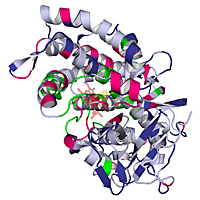A molecular switch turns on the flame in "nature's blowtorch"
New research sheds light on how important enzyme works
 Uncontrolled reaction of organic compounds with oxygen is easy: we call it fire. But nature often needs to do oxidations very specifically, adding oxygen to a particular carbon atom in a complicated molecule without disturbing anything else. Usually, this job falls to an enzyme called cytochrome P450. Because cytochrome P450 can catalyze molecular oxidations with pinpoint accuracy, it has been called “nature's blowtorch,” and its job is analogous to that of a welder doing a tricky repair in a highly flammable wooden house. It needs to do the repair without burning itself or the house.
Uncontrolled reaction of organic compounds with oxygen is easy: we call it fire. But nature often needs to do oxidations very specifically, adding oxygen to a particular carbon atom in a complicated molecule without disturbing anything else. Usually, this job falls to an enzyme called cytochrome P450. Because cytochrome P450 can catalyze molecular oxidations with pinpoint accuracy, it has been called “nature's blowtorch,” and its job is analogous to that of a welder doing a tricky repair in a highly flammable wooden house. It needs to do the repair without burning itself or the house. Brandeis University researchers have been trying to understand the details of how P450 does this job so efficiently; that is, “burning” the right places in the target molecule (substrate) while not “burning down the house.”
In new research online in the Cell Press journal Structure, chemistry graduate student Bo OuYang, along with fellow grad student Marina Dang and advisors Thomas and Susan Pochapsky, describe a new insight into how P450 works. The researchers discovered that the protein chain in P450 can change its structure by a 180 degree rotation around a single peptide bond. In one orientation, both oxygen and the molecule to be oxidized (substrate) can get in and out of the P450 active site, but the oxygen is not “activated,” that is, it is not in a state to react with the substrate (or anything else, for that matter).
In the other orientation, however, the substrate is held tightly in the correct orientation for the oxidation, and the oxygen can be activated to do “the burn.” The activated form of the molecule is generated by binding a helper protein, called Pdx, to the P450. This binding drives the reorientation around the peptide bond, and moves the P450 from the form in which substrate binds to the active form. After the reaction is finished, the Pdx falls off, the P450 moves back to the unactivated state, and the oxidized products are free to leave.
After another substrate molecule and oxygen move into the active site, the cycle can repeat. The reorientation of a single peptide bond, an event called an “isomerization,” thus acts as a molecular switch, moving the P450 between safe and active forms while protecting the P450 and its environment from accidental oxidative damage.
Much of the experimental work for this discovery was done using the NIH-funded 800 MHz NMR spectrometer housed in the Landsman Research Facility at Brandeis University.





